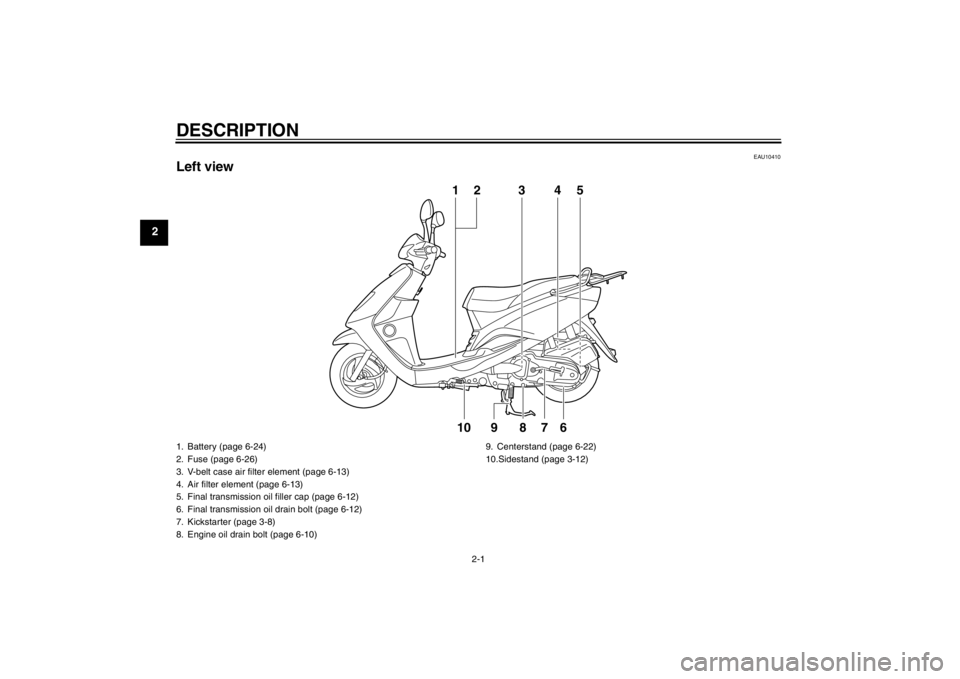engine YAMAHA CYGNUS L 2012 Owners Manual
[x] Cancel search | Manufacturer: YAMAHA, Model Year: 2012, Model line: CYGNUS L, Model: YAMAHA CYGNUS L 2012Pages: 76, PDF Size: 1.56 MB
Page 6 of 76

TABLE OF CONTENTSSAFETY INFORMATION ..................1-1
Further safe-riding points ................1-5
DESCRIPTION ..................................2-1
Left view ..........................................2-1
Right view ........................................2-2
Controls and instruments.................2-3
INSTRUMENT AND CONTROL
FUNCTIONS.......................................3-1
Main switch/steering lock ................3-1
Keyhole cover .................................3-2
Indicator lights and warning light ....3-2
Speedometer unit ...........................3-3
Self-diagnosis device ......................3-3
Fuel gauge ......................................3-4
Handlebar switches ........................3-4
Front brake lever ............................3-5
Rear brake lever .............................3-5
Fuel tank cap ..................................3-5
Fuel .................................................3-6
Catalytic converters ........................3-7
Kickstarter .......................................3-8
Seat ................................................3-8
Helmet holders ...............................3-9
Storage compartments ...................3-9
Carrier ...........................................3-11
Luggage hook ...............................3-11
Grab bar .......................................3-11
Sidestand ......................................3-12
Ignition circuit cut-off system ........3-12FOR YOUR SAFETY –
PRE-OPERATION CHECKS............. 4-1
OPERATION AND IMPORTANT
RIDING POINTS................................. 5-1
Starting the engine ......................... 5-1
Starting off ...................................... 5-2
Acceleration and deceleration ........ 5-2
Braking ........................................... 5-2
Tips for reducing fuel
consumption ............................... 5-3
Engine break-in .............................. 5-3
Parking ........................................... 5-4
PERIODIC MAINTENANCE AND
ADJUSTMENT................................... 6-1
Periodic maintenance chart for
the emission control system ....... 6-3
General maintenance and
lubrication chart .......................... 6-4
Removing and installing cowlings
and panels .................................. 6-7
Checking the spark plug ................. 6-9
Engine oil ..................................... 6-10
Final transmission oil .................... 6-12
Air filter and V-belt case air filter
elements ................................... 6-13
Checking the engine idling
speed ........................................ 6-15
Checking the throttle grip free
play ........................................... 6-15Valve clearance ........................... 6-15
Tires ............................................. 6-16
Cast wheels ................................. 6-17
Checking the front brake lever
free play .................................... 6-18
Adjusting the rear brake lever
free play .................................... 6-18
Checking the front brake pads
and rear brake shoes ............... 6-19
Checking the brake fluid level ...... 6-20
Changing the brake fluid .............. 6-21
Checking and lubricating
the cables ................................. 6-21
Checking and lubricating
the throttle grip and cable ......... 6-21
Lubricating the front and
rear brake levers ...................... 6-22
Checking and lubricating the
centerstand and sidestand ....... 6-22
Checking the front fork ................. 6-23
Checking the steering .................. 6-24
Checking the wheel bearings ....... 6-24
Battery ......................................... 6-24
Replacing the fuse ....................... 6-26
Replacing the headlight bulb ....... 6-26
Replacing a front turn signal
light bulb ................................... 6-27
Rear turn signal light and
tail/brake light ........................... 6-28
Replacing the auxiliary light
bulb ........................................... 6-28U1RSE0E0.book Page 1 Tuesday, October 18, 2011 8:56 AM
Page 9 of 76

SAFETY INFORMATION
1-2
1 cessive speed or undercornering
(insufficient lean angle for the
speed).
Always obey the speed limit and
never travel faster than warrant-
ed by road and traffic conditions.
Always signal before turning or
changing lanes. Make sure that
other motorists can see you.
●
The posture of the operator and
passenger is important for proper
control.
The operator should keep both
hands on the handlebar and
both feet on the operator foot-
rests during operation to main-
tain control of the scooter.
The passenger should always
hold onto the operator, the seat
strap or grab bar, if equipped,
with both hands and keep both
feet on the passenger footrests.
Never carry a passenger unless
he or she can firmly place both
feet on the passenger footrests.
●
Never ride under the influence of
alcohol or other drugs.
●
This scooter is designed for on-
road use only. It is not suitable for
off-road use.
Protective Apparel
The majority of fatalities from scooter
accidents are the result of head inju-
ries. The use of a safety helmet is the
single most critical factor in the preven-
tion or reduction of head injuries.
●
Always wear an approved helmet.
●
Wear a face shield or goggles.
Wind in your unprotected eyes
could contribute to an impairment
of vision that could delay seeing a
hazard.
●
The use of a jacket, substantial
shoes, trousers, gloves, etc., is ef-
fective in preventing or reducing
abrasions or lacerations.
●
Never wear loose-fitting clothes,
otherwise they could catch on the
control levers or wheels and cause
injury or an accident.
●
Always wear protective clothing
that covers your legs, ankles, and
feet. The engine or exhaust sys-
tem become very hot during or af-
ter operation and can cause burns.
●
A passenger should also observe
the above precautions.
Avoid Carbon Monoxide Poisoning
All engine exhaust contains carbon
monoxide, a deadly gas. Breathing car-
bon monoxide can cause headaches,
dizziness, drowsiness, nausea, confu-
sion, and eventually death.
Carbon Monoxide is a colorless, odor-
less, tasteless gas which may be
present even if you do not see or smell
any engine exhaust. Deadly levels of
carbon monoxide can collect rapidly
and you can quickly be overcome and
unable to save yourself. Also, deadly
levels of carbon monoxide can linger
for hours or days in enclosed or poorly
ventilated areas. If you experience any
symptoms of carbon monoxide poison-
ing, leave the area immediately, get
fresh air, and SEEK MEDICAL TREAT-
MENT.
●
Do not run engine indoors. Even if
you try to ventilate engine exhaust
with fans or open windows and
doors, carbon monoxide can rap-
idly reach dangerous levels.
U1RSE0E0.book Page 2 Tuesday, October 18, 2011 8:56 AM
Page 10 of 76

SAFETY INFORMATION
1-3
1
●
Do not run engine in poorly venti-
lated or partially enclosed areas
such as barns, garages, or car-
ports.
●
Do not run engine outdoors where
engine exhaust can be drawn into
a building through openings such
as windows and doors.
Loading
Adding accessories or cargo to your
scooter can adversely affect stability
and handling if the weight distribution of
the scooter is changed. To avoid the
possibility of an accident, use extreme
caution when adding cargo or accesso-
ries to your scooter. Use extra care
when riding a scooter that has added
cargo or accessories. Here, along with
the information about accessories be-
low, are some general guidelines to fol-
low if loading cargo to your scooter:
The total weight of the operator, pas-
senger, accessories and cargo must
not exceed the maximum load limit.
Operation of an overloaded vehicle
could cause an accident.When loading within this weight limit,
keep the following in mind:
●
Cargo and accessory weight
should be kept as low and close to
the scooter as possible. Securely
pack your heaviest items as close
to the center of the vehicle as pos-
sible and make sure to distribute
the weight as evenly as possible
on both sides of the scooter to min-
imize imbalance or instability.
●
Shifting weights can create a sud-
den imbalance. Make sure that ac-
cessories and cargo are securely
attached to the scooter before
riding. Check accessory mounts
and cargo restraints frequently.
Properly adjust the suspension
for your load (suspension-ad-
justable models only), and
check the condition and pres-
sure of your tires. Never attach any large or heavy
items to the handlebar, front
fork, or front fender. Such items
can create unstable handling or
a slow steering response.
●
This vehicle is not designed to
pull a trailer or to be attached to
a sidecar.
Genuine Yamaha Accessories
Choosing accessories for your vehicle
is an important decision. Genuine
Yamaha accessories, which are avail-
able only from a Yamaha dealer, have
been designed, tested, and approved
by Yamaha for use on your vehicle.
Many companies with no connection to
Yamaha manufacture parts and acces-
sories or offer other modifications for
Yamaha vehicles. Yamaha is not in a
position to test the products that these
aftermarket companies produce.
Therefore, Yamaha can neither en-
dorse nor recommend the use of ac-
cessories not sold by Yamaha or
modifications not specifically recom-
mended by Yamaha, even if sold and
installed by a Yamaha dealer.
Maximum load:
165 kg (364 lb)
U1RSE0E0.book Page 3 Tuesday, October 18, 2011 8:56 AM
Page 11 of 76

SAFETY INFORMATION
1-4
1 Aftermarket Parts, Accessories, and
Modifications
While you may find aftermarket prod-
ucts similar in design and quality to
genuine Yamaha accessories, recog-
nize that some aftermarket accessories
or modifications are not suitable be-
cause of potential safety hazards to you
or others. Installing aftermarket prod-
ucts or having other modifications per-
formed to your vehicle that change any
of the vehicle’s design or operation
characteristics can put you and others
at greater risk of serious injury or death.
You are responsible for injuries related
to changes in the vehicle.
Keep the following guidelines in mind,
as well as those provided under “Load-
ing” when mounting accessories.
●
Never install accessories or carry
cargo that would impair the perfor-
mance of your scooter. Carefully
inspect the accessory before using
it to make sure that it does not in
any way reduce ground clearance
or cornering clearance, limit sus-pension travel, steering travel or
control operation, or obscure lights
or reflectors.
Accessories fitted to the handle-
bar or the front fork area can
create instability due to improper
weight distribution or aerody-
namic changes. If accessories
are added to the handlebar or
front fork area, they must be as
lightweight as possible and
should be kept to a minimum.
Bulky or large accessories may
seriously affect the stability of
the scooter due to aerodynamic
effects. Wind may attempt to lift
the scooter, or the scooter may
become unstable in cross
winds. These accessories may
also cause instability when
passing or being passed by
large vehicles.
Certain accessories can dis-
place the operator from his or
her normal riding position. This
improper position limits the free-
dom of movement of the opera-tor and may limit control ability,
therefore, such accessories are
not recommended.
●
Use caution when adding electri-
cal accessories. If electrical acces-
sories exceed the capacity of the
scooter’s electrical system, an
electric failure could result, which
could cause a dangerous loss of
lights or engine power.
Aftermarket Tires and Rims
The tires and rims that came with your
scooter were designed to match the
performance capabilities and to provide
the best combination of handling, brak-
ing, and comfort. Other tires, rims, siz-
es, and combinations may not be
appropriate. Refer to page 6-16 for tire
specifications and more information on
replacing your tires.
Transporting the Scooter
Be sure to observe following instruc-
tions before transporting the scooter in
another vehicle.
●
Remove all loose items from the
scooter.
U1RSE0E0.book Page 4 Tuesday, October 18, 2011 8:56 AM
Page 14 of 76

DESCRIPTION
2-1
2
EAU10410
Left view
1
23
10
9
8
7
64
5
1. Battery (page 6-24)
2. Fuse (page 6-26)
3. V-belt case air filter element (page 6-13)
4. Air filter element (page 6-13)
5. Final transmission oil filler cap (page 6-12)
6. Final transmission oil drain bolt (page 6-12)
7. Kickstarter (page 3-8)
8. Engine oil drain bolt (page 6-10)9. Centerstand (page 6-22)
10.Sidestand (page 3-12)U1RSE0E0.book Page 1 Tuesday, October 18, 2011 8:56 AM
Page 15 of 76

DESCRIPTION
2-2
2
EAU10420
Right view
1
3
2
4
5
9
8
7
6
1. Carrier (page 3-11)
2. Grab bar (page 3-11/5-2)
3. Fuel tank cap (page 3-5)
4. Rear storage compartment (page 3-9)
5. Helmet holder (page 3-9)
6. Front storage compartment (page 3-9)
7. Luggage hook (page 3-11)
8. Spark plug (page 6-9)9. Engine oil filler cap (page 6-10)
U1RSE0E0.book Page 2 Tuesday, October 18, 2011 8:56 AM
Page 17 of 76

INSTRUMENT AND CONTROL FUNCTIONS
3-1
3
EAU45440
Main switch/steering lock The main switch/steering lock controls
the ignition and lighting systems, and is
used to lock the steering. The various
positions are described below.TIPThe main switch/steering lock is
equipped with a keyhole cover. (See
page 3-2.)
EAU10650
ON
All electrical systems are supplied with
power, the headlight, meter lighting,
taillight and auxiliary light come on, and
the engine can be started. The key can-
not be removed.
EAU10661
OFF
All electrical systems are off. The key
can be removed.
WARNING
EWA10061
Never turn the key to “OFF” or
“LOCK” while the vehicle is moving.
Otherwise the electrical systems will
be switched off, which may result in
loss of control or an accident.
EAU49001
LOCK
The steering and the centerstand are
locked, and all electrical systems are
off. The key can be removed.To lock the steering and the center-
stand1. Put the scooter on the center-
stand.
2. Turn the handlebars all the way to
the left.
3. Push the key in from the “OFF” po-
sition, and then turn it to “LOCK”
while still pushing it.
4. Remove the key.TIPWhen the steering is locked, the center-
stand is locked, and the scooter cannot
be taken off it.
ON
OPEN
OPENPUSH
LOCKOFF
1. Push.
2. Turn.12
U1RSE0E0.book Page 1 Tuesday, October 18, 2011 8:56 AM
Page 18 of 76

INSTRUMENT AND CONTROL FUNCTIONS
3-2
3To unlock the steering and the center-
standPush the key in, and then turn it to
“OFF” while still pushing it.
EAUT2121
Keyhole cover To close the keyhole cover
Insert the key bow into the keyhole cov-
er receptacle as shown, and then turn
the key to “SHUT” to close the cover.
To open the keyhole cover
Insert the key bow into the keyhole cov-
er receptacle as shown, and then turn
the key to “OPEN” to open the cover.
EAU11006
Indicator lights and warning
light
EAU11020
Turn signal indicator light “ ”
This indicator light flashes when the
turn signal switch is pushed to the left or
right.
EAU11080
High beam indicator light “ ”
This indicator light comes on when the
high beam of the headlight is switched
on.
1. Push.
2. Turn.12
ON
OPEN
OPENPUSH
LOCK
OFF
1. Engine trouble warning light “ ”
2. High beam indicator light “ ”
3. Turn signal indicator light “ ”
123
U1RSE0E0.book Page 2 Tuesday, October 18, 2011 8:56 AM
Page 19 of 76

INSTRUMENT AND CONTROL FUNCTIONS
3-3
3
EAUT1934
Engine trouble warning light “ ”
This warning light flashes or stays on if
an electrical circuit monitoring the en-
gine is not working correctly. If this oc-
curs, have a Yamaha dealer check the
self-diagnosis system.
The electrical circuit of the warning light
can be checked by turning the key to
“ON”. The warning light should come
on for a few seconds, and then go off.
If the warning light does not come on
initially when the key is turned to “ON”,
or if the warning light remains on, have
a Yamaha dealer check the electrical
circuit.
EAUT1821
Speedometer unit The speedometer unit is equipped with
a speedometer and an odometer. The
speedometer shows the riding speed.
The odometer shows the total distance
traveled.
EAU12093
Self-diagnosis device This model is equipped with a self-diag-
nosis device for various electrical cir-
cuits.
If a problem is detected in any of those
circuits, the engine trouble warning light
will come on or flash. If this occurs,
have a Yamaha dealer check the vehi-
cle.NOTICE
ECA11170
To prevent engine damage, be sure
to consult a Yamaha dealer as soon
as possible if this occurs.
1. Speedometer
2. Odometer
1
2
1. Engine trouble warning light “ ”
1
U1RSE0E0.book Page 3 Tuesday, October 18, 2011 8:56 AM
Page 20 of 76

INSTRUMENT AND CONTROL FUNCTIONS
3-4
3
EAU45630
Fuel gauge The fuel gauge indicates the amount of
fuel in the fuel tank. The needle moves
towards “E” (Empty) as the fuel level
decreases. When the needle reaches
the red line, refuel as soon as possible.TIPTurning the key to “OFF” cancels the
fuel gauge reading.
EAU1234A
Handlebar switches Left
Right
EAU12400
Dimmer switch “ / ”
Set this switch to “ ” for the high
beam and to “ ” for the low beam.
EAU12460
Turn signal switch “ / ”
To signal a right-hand turn, push this
switch to “ ”. To signal a left-hand
turn, push this switch to “ ”. When re-
leased, the switch returns to the center
position. To cancel the turn signal
lights, push the switch in after it has re-
turned to the center position.
EAU12500
Horn switch “ ”
Press this switch to sound the horn.
EAU12721
Start switch “ ”
With the sidestand up, push this switch
while applying the front or rear brake to
crank the engine with the starter. See
page 5-1 for starting instructions prior
to starting the engine.
1. Fuel gauge
2. Red line
1
2
1. Dimmer switch “ / ”
2. Turn signal switch “ / ”
3. Horn switch “ ”
1. Start switch “ ”
2 13
1
U1RSE0E0.book Page 4 Tuesday, October 18, 2011 8:56 AM